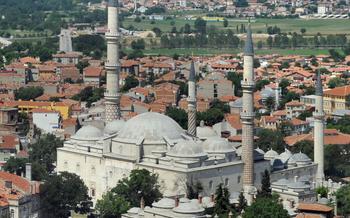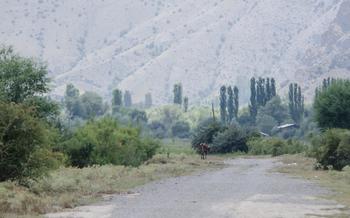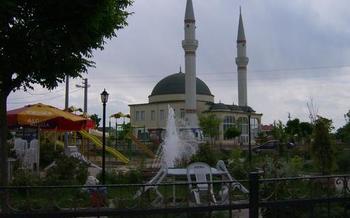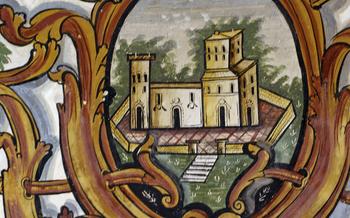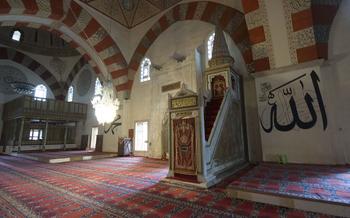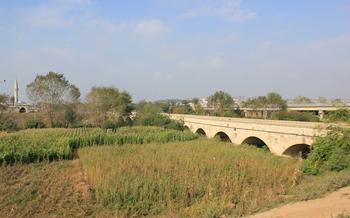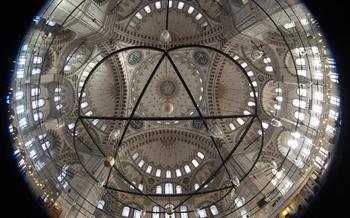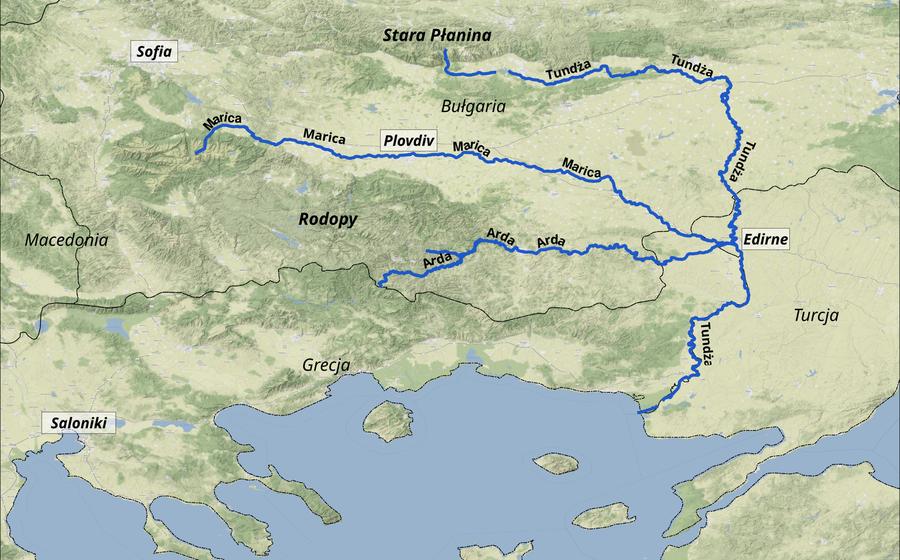
Beyazid II Mosque and Complex
- History of the Beyazid II Mosque and Complex
- Architecture of the Beyazid II Mosque
- Visiting the Beyazid II Mosque and Complex
- The Beyazid II Mosque's Interior
- The Beyazid II Mosque's Exterior:
- The Beyazid II Mosque's Minaret
- The Beyazid II Mosque's Madrasah
- The Beyazid II Mosque's Imaret
- The Beyazid II Mosque's Museum
- The Beyazid II Mosque's Library
- The Beyazid II Mosque's Surroundings
- The Beyazid II Mosque's Festivals and Events
- The Beyazid II Mosque's Conservation and Restoration
- Insider Tip: Uncover the Hidden Gem of the Beyazid II Mosque's Library
History of the Beyazid II Mosque and Complex
The Beyazid II Mosque and Complex is a magnificent architectural masterpiece dating back to the late 15th century. The brainchild of the revered Ottoman Sultan Beyazid II, this majestic complex stands as an enduring legacy of the Sultan's reign. Its construction commenced in 1484 under the watchful eye of the renowned architect Hayreddin, who meticulously labored to bring the Sultan's vision to life. Completed in 1488, the mosque and its accompanying structures have remained a source of awe and inspiration for generations, earning its rightful place as a UNESCO World Heritage Site.
The complex's significance extends beyond its architectural grandeur. It served as a vibrant center of Islamic learning, with a madrasah, or religious school, where students delved into the intricacies of Islamic theology, law, and philosophy. Furthermore, the complex housed an imaret, a charitable institution that provided food and shelter to the needy, exemplifying the Ottoman Empire's commitment to social welfare. The mosque's construction not only transformed Edirne's skyline but also played a pivotal role in shaping the city's identity as a prominent center of Islamic culture and education.
Architecture of the Beyazid II Mosque
The Beyazid II Mosque stands as a testament to the architectural brilliance of the Ottoman Empire. Its unique design incorporates various architectural elements from both Byzantine and Islamic traditions, creating a harmonious blend of East and West. The mosque's exterior is characterized by its large dome, which is supported by four massive pillars. The dome is topped with a crescent, symbolizing Islam, and is surrounded by four smaller domes, each adorned with intricate geometric patterns. The mosque's minarets, towering over the city of Edirne, are a hallmark of its skyline. Their slender design and elegant proportions create a sense of verticality and lightness.
The mosque's interior is equally impressive, showcasing a fusion of Islamic and Byzantine artistic traditions. The walls are decorated with intricate tilework, featuring vibrant colors and geometric designs. The mihrab, the niche indicating the direction of prayer, is a masterpiece of craftsmanship, adorned with colorful tiles and intricate calligraphy. The qibla wall, facing Mecca, is another focal point of the mosque's interior, featuring beautiful calligraphy and decorative elements. The overall effect of the mosque's interior is one of awe and inspiration, reflecting the grandeur and piety of the Ottoman Empire.
Visiting the Beyazid II Mosque and Complex
When visiting the Beyazid II Mosque and Complex, it is essential to be respectful of the religious and cultural significance of the site. Visitors should dress modestly and avoid wearing shorts or revealing clothing. It is also important to be quiet and not disturb those who are praying or studying. The mosque is open to visitors daily, but it is best to avoid visiting during prayer times, which are usually around dawn, midday, afternoon, sunset, and night. Visitors can explore the mosque's interior and exterior, as well as the surrounding gardens. Guided tours are available, providing visitors with a deeper understanding of the mosque's history and architecture. The complex also has a museum and a library that visitors can explore.
The Beyazid II Mosque's Interior
The interior of the Beyazid II Mosque is as impressive as its exterior. The mosque's vast prayer hall is adorned with intricate tilework and calligraphy, creating a sense of awe and wonder. The mihrab, the niche indicating the qibla, is particularly noteworthy for its exquisite craftsmanship and intricate design. The minbar, the pulpit from which the imam delivers the sermon, is also a masterpiece of Islamic art, with its finely carved wood and mother-of-pearl inlay.
The qibla wall, the wall facing Mecca, is adorned with beautiful tilework and calligraphy, creating a focal point for the prayer hall. Other decorative elements in the mosque include stained glass windows, elaborate chandeliers, and carved wooden panels. The overall effect is one of grandeur and opulence, befitting a mosque built by one of the most powerful sultans of the Ottoman Empire.
The Beyazid II Mosque's Exterior:
The exterior of the Beyazid II Mosque is just as impressive as its interior. The mosque's large dome and minarets are its most striking features. The dome, which is covered in lead, has a diameter of 24 meters and a height of 34 meters. It is supported by four massive pillars and is topped by a large finial. The mosque's four minarets are each 68 meters tall and are decorated with intricate tilework. The minarets are topped by conical roofs and each has three balconies.
The mosque's courtyard is surrounded by a covered arcade, which is supported by 28 marble columns. The arcade provides shade and shelter for visitors, and is a popular place to relax and take in the view of the mosque. The courtyard is also home to a number of fountains, which add to the tranquil atmosphere of the mosque.
The Beyazid II Mosque is surrounded by lush gardens, which provide a beautiful backdrop to the mosque. The gardens are planted with a variety of trees, flowers, and shrubs, and are a popular spot for visitors to take a stroll and enjoy the fresh air.
The Beyazid II Mosque offers stunning views of the city of Edirne. From the top of the minarets, visitors can see the city's many mosques, churches, and other historical buildings. The views of the city are especially beautiful at sunset, when the city is bathed in a golden light.
The Beyazid II Mosque's Minaret
The Beyazid II Mosque boasts two tall and slender minarets, which are among its most striking features. These minarets stand proudly on either side of the mosque's main entrance, reaching towards the sky. Their unique architectural design sets them apart from other minarets in the region. The minarets are adorned with intricate tilework and calligraphy, reflecting the mosque's overall aesthetic.
Their primary function is to serve as platforms for the muezzin, or caller to prayer, to perform the adhan, or call to prayer. The muezzin's voice reverberates through the city of Edirne, inviting the faithful to prayer five times a day. The minarets also play a crucial role in determining the direction of qibla, the direction facing Mecca, which is essential for Muslims during prayers.
In addition to their religious significance, the minarets offer visitors breathtaking views of the city and the surrounding area. Visitors can climb the narrow spiral staircases inside the minarets to reach the viewing platforms at the top. From there, they can enjoy panoramic views of Edirne, including the mosque's impressive dome, the city's historic landmarks, and the lush green countryside beyond.
The Beyazid II Mosque's Madrasah
The Beyazid II Mosque's madrasah, also known as the Sahn1488, it played a crucial role in training Islamic scholars and jurists. The madrasah's curriculum encompassed various Islamic sciences, including Quranic studies, hadith, fiqh (Islamic jurisprudence), and Arabic language and literature. Renowned scholars and theologians taught at the madrasah, attracting students from across the Ottoman Empire and beyond.
The madrasah's teaching methods emphasized memorization, critical thinking, and debate. Students engaged in lively discussions and debates on various religious and philosophical topics, fostering a vibrant intellectual atmosphere. The madrasah also possessed a rich library, housing a vast collection of Islamic texts and manuscripts that students could access for research and study. Graduates of the madrasah often went on to hold prominent positions in the Ottoman bureaucracy, judiciary, and religious establishment, contributing to the empire's intellectual and cultural development.
The Beyazid II Mosque's madrasah stands as a testament to the Ottoman Empire's commitment to education and Islamic scholarship. Its legacy continues to inspire and influence Islamic education institutions worldwide.
The Beyazid II Mosque's Imaret
The Beyazid II Mosque's imaret was an essential part of the complex, providing food and shelter for the needy. Established by Sultan Beyazid II in 1488, the imaret operated as a charitable institution, distributing meals to the poor and travelers. It was also a place where the homeless and orphans could find refuge and assistance. The imaret's kitchen was renowned for its large cooking pots, which could feed thousands of people daily. The imaret's operation was supported by revenues from the mosque's vast landholdings, demonstrating the mosque's commitment to social welfare and community support.
The imaret's architectural design reflected its function as a charitable institution. It comprised a large dining hall, a kitchen, and storage facilities. The dining hall was a vast space with a high ceiling, allowing for good ventilation and accommodating a large number of people. The kitchen was equipped with multiple cooking pots, ovens, and other utensils necessary for preparing and distributing food. The storage facilities ensured a steady supply of ingredients and provisions for the imaret's operations.
The Beyazid II Mosque's imaret played a significant role in Ottoman social welfare, providing sustenance and shelter to those in need. Its charitable activities were a testament to the mosque's commitment to social justice and community support. The imaret's architectural design reflected its function, ensuring efficiency and practicality in serving the community.
The Beyazid II Mosque's Museum
The Beyazid II Mosque's museum is a treasure trove of Islamic artifacts and manuscripts. The museum's collection includes rare and valuable items such as Qur'ans, prayer rugs, and calligraphy. Visitors can also learn about the history of the mosque and complex through exhibits and displays.
The museum is located within the mosque's complex and is open to the public. It is a great place to learn more about Islamic art and culture. The museum also offers educational programs and activities for visitors of all ages.
Insider Tip:
If you are interested in learning more about Islamic art and culture, be sure to visit the Beyazid II Mosque's museum. The museum's collection is extensive and the exhibits are well-curated. You can easily spend several hours exploring the museum and learning about the history of the mosque and complex.
The Beyazid II Mosque's Library
The Beyazid II Mosque's library is a treasure trove of Islamic knowledge. It houses a vast collection of rare books and manuscripts, covering a wide range of subjects, including theology, philosophy, history, literature, and science. These precious volumes are meticulously preserved in a serene and scholarly environment, providing a sanctuary for researchers and scholars from around the world.
The library's collection is particularly renowned for its extensive selection of Qur'anic manuscripts, some of which date back to the early centuries of Islam. These manuscripts are not only of great religious significance but also offer valuable insights into the development of Islamic calligraphy and illumination. The library also boasts a rich collection of works by renowned Islamic scholars, such as al-Ghazali, Ibn Sina, and Ibn Rushd, whose writings have profoundly influenced Islamic thought and scholarship.
Beyond its collection of Islamic texts, the library also houses a significant number of manuscripts in other languages, including Persian, Arabic, and Turkish. These works cover a diverse range of topics, from history and geography to poetry and medicine, reflecting the cosmopolitan nature of the Ottoman Empire. The library's collection is a testament to the empire's commitment to preserving and promoting knowledge and learning.
The Beyazid II Mosque's library is not merely a repository of books; it is a living center of Islamic scholarship. Scholars from around the world come to the library to conduct research, consult rare manuscripts, and engage in intellectual discourse. The library's staff is dedicated to providing assistance to researchers and facilitating their work. They organize lectures, workshops, and conferences to promote Islamic scholarship and encourage dialogue between scholars from different backgrounds.
The Beyazid II Mosque's library is a vital resource for anyone interested in exploring the rich history and traditions of Islam. It is a place where knowledge is cherished, preserved, and shared, contributing to the advancement of Islamic scholarship and the preservation of Islamic heritage for future generations.
The Beyazid II Mosque's Surroundings
The Beyazid II Mosque is situated in the heart of the historic city of Edirne, a city steeped in history and cultural heritage. The mosque's location within the city walls places it in close proximity to numerous other historical sites and attractions, such as the Selimiye Mosque, the Üç Şerefeli Mosque, and the Edirne Palace. Visitors to the Beyazid II Mosque can easily explore these other landmarks, creating a comprehensive itinerary that delves into the rich history of Edirne.
Beyond its historical significance, the Beyazid II Mosque also plays a vital role in the local community. It serves as a place of worship, a center for religious education, and a gathering place for social events. The mosque's presence in the neighborhood contributes to a sense of community and belonging among the local residents. Furthermore, the mosque's architectural grandeur and historical significance make it a popular tourist attraction, drawing visitors from around the world. The mosque's status as a UNESCO World Heritage Site further enhances its appeal, attracting tourists who seek to experience the cultural and historical treasures of Edirne.
The Beyazid II Mosque's Festivals and Events
The Beyazid II Mosque is not just a place of worship but also a vibrant hub for cultural and community events. Throughout the year, the mosque hosts a variety of festivals and celebrations that draw both locals and tourists alike. These events provide a unique opportunity to experience the mosque's rich Islamic heritage and traditions firsthand.
One of the most significant festivals held at the mosque is the annual Mevlid-i Nebi, which commemorates the birth of Prophet Muhammad. During this festival, the mosque is decorated with colorful lights and flowers, and special prayers and recitations are held. Visitors can also enjoy traditional Turkish music, dance, and food stalls set up in the mosque's courtyard.
Another popular event is the Laylat al-Qadr, which marks the night when the Quran was first revealed to Prophet Muhammad. On this night, the mosque stays open all night, and visitors can participate in special prayers, قرآن recitations, and spiritual reflections.
In addition to these religious festivals, the Beyazid II Mosque also hosts cultural events such as art exhibitions, calligraphy workshops, and concerts. These events provide a platform for local artists and performers to showcase their talents and share their culture with the wider community.
By participating in these festivals and events, visitors can gain a deeper understanding of Islamic traditions and customs and experience the vibrant cultural heritage of Edirne.
The Beyazid II Mosque's Conservation and Restoration
Throughout its long history, the Beyazid II Mosque has undergone several conservation and restoration efforts to preserve its architectural integrity and historical significance. The first major restoration took place in the 16th century during the reign of Sultan Suleiman the Magnificent, who ordered repairs to the mosque's dome and minarets. Subsequent restoration projects were carried out in the 18th and 19th centuries, focusing on the mosque's interior decoration and structural reinforcement.
In the 20th century, the mosque underwent a comprehensive restoration project led by the Turkish Ministry of Culture and Tourism. This project involved the restoration of the mosque's exterior and interior, including the repair of the dome, minarets, and tilework. The project also included the restoration of the mosque's complex, including the madrasah, imaret, and museum.
Despite these efforts, the mosque continues to face challenges to its preservation. The mosque's location in a seismic zone makes it vulnerable to earthquakes, and the passage of time has taken its toll on the mosque's materials and structures. To address these challenges, the Turkish government and UNESCO have collaborated to develop a comprehensive conservation plan for the mosque.
The conservation plan focuses on protecting the mosque from natural disasters, maintaining its structural integrity, and preserving its historical and cultural value. The plan includes measures such as seismic retrofitting, regular maintenance, and the use of traditional building techniques and materials. By implementing this plan, the Beyazid II Mosque will be preserved for future generations as a testament to Ottoman architecture and Islamic heritage.
Insider Tip: Uncover the Hidden Gem of the Beyazid II Mosque's Library
Delve into the depths of knowledge at the Beyazid II Mosque's hidden gem – its remarkable library. Step into a world of ancient wisdom as you peruse the shelves adorned with rare manuscripts and books, some dating back centuries. Discover priceless Islamic texts, historical chronicles, and scientific treatises that have shaped the intellectual landscape of the region. Immerse yourself in the tranquil ambiance of the library, a sanctuary for scholars and history enthusiasts alike. The Beyazid II Mosque's library is a testament to the enduring power of knowledge and a must-visit for anyone seeking a glimpse into the rich cultural heritage of Edirne.

